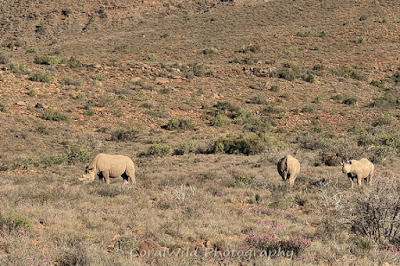 |
| Black (Hook-lipped) Rhino (l) and White (Square-lipped) Rhino (r) |
Southern Africa has 2 rhino species that we may be really lucky to see whilst on safari in our national parks.
The original "Big 5", the term originating from the hunting community, listed the Black Rhino.
This was basically because the White Rhino was driven to the brink of extinction by the end of the 19th century and only existed in tiny numbers in 1 or 2 locations in southern Africa.
However, successful conservation and protection of that tiny population of White Rhino in Kwa-Zulu Natal ultimately led to significant numbers of White Rhino being trans-located and re-introduced into conservation areas in their former ranges (and outside those in some cases).
Increasing eco-tourism led to safari promoters using the term "Big 5" as a catch phrase for the quintessential African safari. And this list uses the White Rhino.
Basically because it is easier to find!!
 |
| Black Rhino (top) and White Rhino (bottom) |
I can count on 2 hands the number of times I've seen black rhino on safari, whereas it's probably 3-4 out of every 5 safaris that we see white rhino.
Black Rhino browse (eating leaf & twigs) and therefore usually live in thick bush, are more often solitary, shy, aggressive and unpredictable.
As a result, they are hard to find and estimates of their numbers vary widely.
It's always a wonderful surprise to spot one.
Of course - they're not always in thick bush (or solitary) - it depends on the area.
These black rhino are in a semi-arid area - still browsing - but on the low level shrubby vegetation....
 |
| A "crash" of white rhino |
White Rhino are grazers (eat grass) and are often found in more open savannah. However, as long as there is abundant grass one can also find them in thicker bush.
 |
| Female white rhino and sub-adult calf |
In my experience, white rhino with the really long front horns are older females.
 |
| Female white rhino and calf |
 |
| white rhino calf |
 |
| white rhino calf with oxpecker |
Of course, horn length can also be used as a very rough indication of age (in combination with body size of course!).
 |
| young adult white rhino with oxpecker |
Otherwise, although adult, mature male white rhinos are the largest individuals (1.8m high at the shoulder) it is very difficult to tell the males & females apart.
And that bird that you almost always see at least one of on a rhino..... ?
It's the red-billed ox-pecker, keeping itself fed on, and the rhino clean of, skin parasites like ticks. They also act as an alarm system, flying off and calling loudly when other large animals approach.





3 comments:
Thanks, Sue. They are glorious. I didn't know it was difficult to tell the males and females apart, I learn something new every day. Presumably they themselves know - or are there more unintentional gay couples among rhinos than in most other species! xDiana.
ps ... and bewildered non-parents! xD
Enjoyed your tutorial on rhino, Sue. Did "The Big 5" originate with Frederick Selous? So encouraging to read how White Rhino are thriving. Your blog is a refreshing antidote to the constant revelations about poaching and corruption. Bravo to those who care for rhinos!
Post a Comment